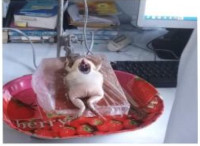Cardiotonic Effects of Oral Antimalarial Drugs on In-Situ Frog Heart
DOI:
https://doi.org/10.51412/psnnjp.2025.35Keywords:
Chloroquine, artemether-lumefantrine, artesunate, frog heart, cardiotoxicity, chronotropic effect, inotropic effectAbstract
Background: Antimalarial drugs remain essential for malaria control, but concerns persist about their potential cardiovascular effects. Chloroquine, artemether-lumefantrine, and artesunate are widely prescribed, yet their impact on myocardial activity is incompletely understood. This study evaluated the cardiotonic effects of these drugs using an in-situ frog heart model.
Methods: Three frogs were pithed, and isolated heart preparations were mounted on a force transducer. Baseline heart rate, contraction amplitude (mV), and force of contraction (gram force, gF) were recorded. Chloroquine was administered at 10 mg/kg (therapeutic) and 100 mg/kg (supratherapeutic), artemether-lumefantrine at 4 mg/kg and 40 mg/kg, and artesunate at 4 mg/kg and
40 mg/kg. Saline served as control. Percentage changes in cardiac parameters relative to baseline were analyzed.
Results: Chloroquine produced a dose-dependent bradycardia, reducing heart rate from 75 bpm at baseline to 66 bpm at therapeutic and 60 bpm at supratherapeutic doses. Contractile amplitude fell modestly at the therapeutic dose (−3.7%) but increased at supratherapeutic concentration (+0.5%). Force of contraction decreased slightly at therapeutic dose (2.6 gF) but rose at higher concentration (2.8 gF) at supratherapeutic dose. Artemether-lumefantrine exhibited minimal cardiac impact: heart rate remained unchanged at therapeutic dose (39 bpm) and decreased only slightly at supratherapeutic dose (36 bpm). Contractile force fell consistently by 2.3% across both doses. Artesunate demonstrated a contrasting profile, increasing heart rate markedly at therapeutic dose (from 36 to 51 bpm) but reducing contractile amplitude (−18%) and force of contraction (from 11.7 to 9.6 gF). At supratherapeutic levels, heart rate rose to 42 bpm, while contractile force remained depressed (9.8 gF).
Conclusion: Chloroquine exerted a dose-dependent negative chronotropic effect, with paradoxical increases in contractility at higher doses, consistent with its cardiotoxic profile. Artemetherlumefantrine showed negligible cardiodepressive effects, reinforcing its safety. Artesunate induced pronounced tachycardia but reduced myocardial contractility, warranting further mechanistic studies. The in-situ frog heart model effectively revealed these drug-specific cardiac effects, highlighting the need for pharmacovigilance in antimalarial therapy
References
1. World Health Organization. World malaria report 2023. Geneva: WHO; 2023.
2. Renslo AR. Antimalarial drug discovery: from quinine to the dream of eradication. ACS Med Chem Lett. 2013;4(12):1126–8.
3. White NJ. Antimalarial drug resistance. J Clin Invest. 2004;113(8):1084–92.
4. Thanacoody RH. Quinine and chloroquine. Medicine (Abingdon). 2016;44(10):622–4.
5. Marrelli MT, Brotto M. The effect of malaria and anti-malarial drugs on skeletal and cardiac muscles. Malar J. 2016;15(1):524.
6. Zimmer HG. The isolated perfused heart and its pioneers. Physiology. 1998;13(4):203–10.
7. D a n g i S Y, J o ll y C I , N a r a y a n a n S. Antihypertensive activity of the total alkaloids from the leaves of Moringa oleifera. Pharm Biol.
2002;40(2):144–8.
8. Kothapalli J. Effect of atropine on cardiac rhythm of frog's heart. Int J Adv Res. 2017;5(4):123–6.
9. Knight VA, Richardson DR, Makoba B. Use of frog ventricle to examine mechanical and electrical activity of heart. Am J Physiol. 1989;256(6 Pt 2):S9–S14.
10. Olejníčková V, Nováková M, Provazník I. Isolated heart models: cardiovascular system studies and technological advances. Med Biol
Eng Comput. 2015;53(4):547–56.
11. So w u n m i A , Sa l a k o L A , Wa l k e r O . Cardiovascular effects of chloroquine in children with malaria. Trans R Soc Trop Med Hyg.
1999;93(3):320–3.
12. Thanacoody RH. Extracellular and intracellular consequences of chloroquine poisoning. Toxicol Rev. 2016;35(3):185–92.
13. White NJ. Cardiotoxicity of antimalarial drugs. Lancet Infect Dis. 2007;7(8):549–58.
14. Sequeira V, van der Velden J. Historical perspective on heart function: the Frank–Starling law. Biophys Rev. 2015;7(4):421–47.
15. Zimmer HG. The role of mechanical stretch in cardiac hypertrophy. Mol Cell Biochem. 2019;241(1–2):1–11.
16. Phillips-Howard PA, ter Kuile FO. CNS adverse events associated with antimalarial drugs. Drug Saf. 1995;12(6):370–83.
17. Chorin E, Wadhwani L, Magnani S, et al. QT interval prolongation and torsade de pointes in pa ti ents with COVID-19 tr e a t ed with
hydroxychloroquine/azithromycin. Heart Rhythm. 2020;17(9):1425–33.
18. Degen P, Juillard P, de Riedmatten M. Assessment of cardiac safety during treatment with artemether–lumefantrine in healthy volunteers.
Clin Drug Investig. 2002;22(3):169–79.
19. World Health Organization. Guidelines for the treatment of malaria. 3rd ed. Geneva: WHO; 2015.
20. Manyando C, Njunju EM, D'Alessandro U, Van Geertruyden JP. Safety and efficacy of artemether–lumefantrine in pregnancy: a systematic review. Malar J. 2012;11:141.
21. Ashley EA, Stepniewska K, Lindegardh N, et al. Population pharmacokinetic assessment of a new regimen of artemether-lumefantrine in patients with uncomplicated falciparum malaria. A n t i m i c r o b A g e n t s C h e m o t h e r . 2007;51(12):4090–7.
22. Borsini F, Crumb W, Pace S, et al. In vitro c a r d i o v a s c u l a r e ff e c t s o f dihydroartemisinin–piperaquine compared with other antimalarials. Antimicrob Agents Chemother. 2012;56(6):3261–70.
23. Gordi T, Lepist EI. Artemisinin derivatives: toxic for laboratory animals, safe for humans? Toxicol Lett. 2004;147(2):99–107.
24. Maude RJ, Plewes K, Faiz MA, et al. Does artesunate prolong the electrocardiograph QT interval in patients with severe malaria? Am J
Trop Med Hyg. 2009;80(1):126–32.
25. Olejníčková V, Nováková M, Provazník I. Isolated heart models: cardiovascular system studies and technological advances. Med Biol Eng Comput. 2015;53(4):547–56

Downloads
Views | PDF Downloads:
106
/ 49
Published
How to Cite
Issue
Section
License

This work is licensed under a Creative Commons Attribution-NonCommercial 4.0 International License.


